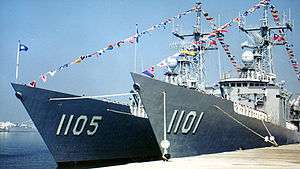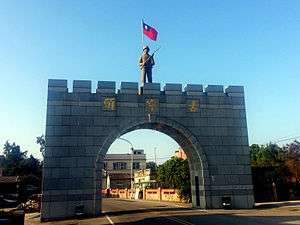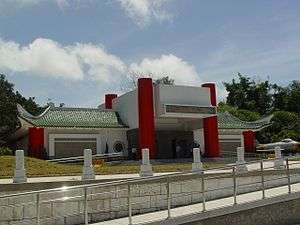Republic of China Armed Forces
| Republic of China Armed Forces | |
|---|---|
|
中華民國國軍 Zhōnghuá Mínguó Guójūn | |
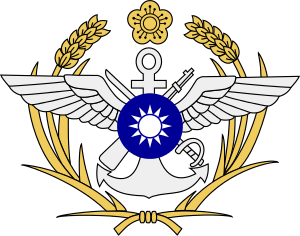 Emblem of the Ministry of National Defense | |
| Founded | June 16, 1924 |
| Current form | December 25, 1947 |
| Service branches |
|
| Headquarters | Taipei, Taiwan |
| Leadership | |
| Commander-in-Chief |
|
| Minister of National Defense |
|
| Chief of the General Staff |
|
| Manpower | |
| Military age | 18 – 40 years of age |
| Conscription | 1 year compulsory military services for male citizens between the age of 19 and 40 |
| Available for military service | 5,883,828, age 15–40 (2005 est.) |
| Fit for military service | 4,749,537, age 15–40 (2005 est.) |
| Reaching military age annually | 174,173 (2005 est.) |
| Active personnel | 275,000 (ranked 16th) |
| Reserve personnel | 2,800,000 |
| Expenditures | |
| Budget | US$10.6 billion(2017)[1] |
| Percent of GDP | 2.5 (2008 est.) |
| Industry | |
| Domestic suppliers |
Aerospace Industrial Development Corporation Chungshan Institute of Science and Technology CSBC Corporation 205th Armory |
| Foreign suppliers |
Former: |
| Related articles | |
| History |
Historical Chinese wars and battles List of wars the Republic of China involved in War on Terror Military intervention against ISIL |
| Ranks |
Army ranks Navy ranks Air Force ranks |
| Republic of China Armed Forces | |||||||||
| Simplified Chinese | 中华民国国军 | ||||||||
|---|---|---|---|---|---|---|---|---|---|
| Traditional Chinese | 中華民國國軍 | ||||||||
| Literal meaning | Republic of China Army | ||||||||
| |||||||||
| Shorter name: National Army | |||||||||
| Simplified Chinese | 国军 | ||||||||
| Traditional Chinese | 國軍 | ||||||||
| |||||||||
| Former name: National Revolutionary Army | |||||||||
| Simplified Chinese | 国民革命军 | ||||||||
| Traditional Chinese | 國民革命軍 | ||||||||
| |||||||||
The Republic of China Armed Forces, also known as the Chinese National Armed Forces (CNAF) or Armed Forces of Taiwan are the armed forces of the Republic of China now on Taiwan, encompassing the Army, Navy (including the Republic of China Marine Corps), Air Force and Military Police Force. It is a military establishment, which accounted for 16.8% of the central budget in the fiscal year of 2003. Since 2002, the military comes under the full civilian control of the Ministry of National Defense and oversight by the Legislative Yuan. It was the National Revolutionary Army before being renamed as the Republic of China Armed Forces in 1947 due to the implementation of the newly promulgated Constitution of the Republic of China (ROC).[3] The ROC Army, including Generalissimo Chiang Kai Shek [4] has strong historical bond with the Green Gang for the convenience of leading the army troop.[5][6]
Until the 1970s, the military's primary mission was to retake mainland China from the communist People's Republic of China (PRC) through the Project National Glory.[7] The military's current foremost mission is the defense of the islands of Taiwan, Penghu, Kinmen, Matsu, and other ROC's islands against a possible military invasion by the People's Liberation Army of the People's Republic of China (PRC), which is seen as the predominant threat to the Republic of China (ROC)[8][9] in the ongoing dispute over the political status of Taiwan.
Names
The Republic of China Armed Forces is the National Defense Force of ROC. It is known as "Guojun 國軍", which means "national army".
When the ROC was ruled on whole China, its army was the National Revolutionary Army before 1928 which was often known as the "Chinese Nationalist Army" or "KMT Army". The nationalization of the armed forces in 1947 basically detached the Kuomintang's control on the armed forces, and it became a national defense forces. Due to the institution of civilian control of the military and the new 1947 constitution, it was later renamed the Republic of China Armed Forces.
The ROC central government was forced into exile into Taiwan island after 1949, the Republic of China Armed Forces is still called Chinese National Armed Forces, until the outcome of the 2000 election was that Chen Shui-bian was elected as President. After Democratic Progressive Party rule on ROC in 2000, the Republic of China Armed Forces is also informally called Taiwan Armed Forces following a relocation to prevent being confused with the communist-led People's Liberation Army(People's Republic of China).
History
Origin and nationalization
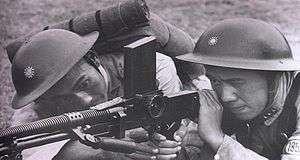
The earliest use of the name "Republic of China Armed Forces (中華民國國軍)" can be found in the first Constitution of the Republic of China in the Beiyang Government in 1923.[10]
The Republic of China's army was known as the National Revolutionary Army, which was founded on mainland China in 1925. The National Revolutionary Army was the military arm of Kuomintang (Nationalist Party - KMT) from 1925 until 1947 in the Republic of China. It also become the regular army of the ROC during the KMT's period of party rule beginning in 1928.
However, with the promulgation of the second Constitution of the Republic of China in 1947 and the formal end of the KMT party-state, the National Revolutionary Army was renamed the Republic of China Armed Forces (中華民國國軍), while the bulk of its forces formed the Republic of China Army. The army was nationalized and thus no longer belonged to the KMT. The ROC Armed Force relocated to the island of Taiwan after the end of the second phase of the Chinese Civil War in 1949.
ROC Army
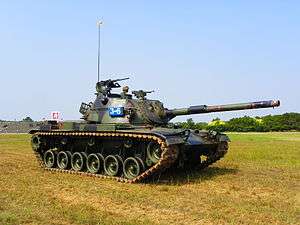
The Land force was established in 1924. It can be traced back to the establishment of the Whampoa Military Academy in Canton by 1911 revolutionary leader Sun Yat-sen and built as the National Revolutionary Army, the military arm of KMT. Whampoa Military Academy was relocated to Fengshan District, Kaohsiung City, Taiwan after 1949. It was re-established as the Republic of China Military Academy (中華民國陸軍軍官學校), and modeled after the United States Military Academy at West Point, New York.
ROC Navy
The Navy of the Qing dynasty was first exposed to Western influence. With the establishment of the Republic of China in 1912, many former Qing-naval officer agreed with the revolutionary ideal of Xinhai and joined the ROC Navy. However, with warlordism continuing to plague the territory of the Republic of China, the development of the Republican navy was somewhat slow. Furthermore, there were internal conflicts during its development. During the 2nd Sino-Japanese war, most of the ROC Navy was destroyed by the Imperial Japanese Navy. In 1946 the Republic of China Naval Academy was established in Shanghai; it was relocated to Taiwan in 1949.
ROC Marine Corps

The ROC Marine Corps was formed from the former Navy Sentry Corps in December 1914, it used to have two divisions, 66th and 99th divisions, in size, when its doctrine focused on retaking mainland China. Since its transition to a defensive posture, the ROCMC has been downsized from about 38,000 active personnel to only 9,000. In 2004, the ROCMC redeployed a brigade near the Taipei area to defend against a possible PLA decapitation strike. The ROC Marine Corps' official motto is "永遠忠誠" (Forever Loyalty), modeled after the US Marine Corps's "Semper Fidelis".
ROC Air Force
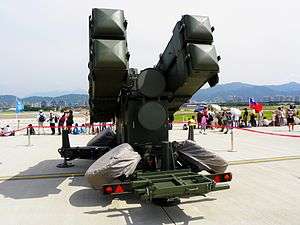
In 1920 Sun Yat-sen established the Aviation Ministry in Canton(Guangdong Province). But due to the division of the Southern Warlords, it was later dismantled. In 1929, Chiang Kai-shek established the Aviation Class in the ROC Military Academy. It was relocated to Hangzhou in 1931. Following the outbreak of the 2nd Sino-Japanese War, the ROC Air Force was responsible for shooting down many Japanese Air force fighters. After 1949 the ROC Air Force Academy was relocated to Taiwan island.
ROC Military Police
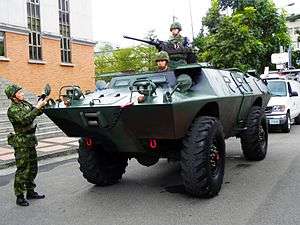
The ROC Military Police was established in 1914 when Sun Yat-sen assumed the provisional presidency. It was established as a police guard and to maintain discipline within the army. In 1932 the nationalist government established the "Command Work of Military Police" (憲兵勤務令) and the Service Procedure for the Military Police (憲兵服務章程), which established the military police system. In 1936, the Military police Academy was founded in Nanjing. The school relocated to Taiwan after 1949.
Rise of the PRC
In the 21st century as the PRC vastly increased its defense spending, Taiwan registered the lowest growth in defense spending of the major Asia-Pacific powers.[11] These cutbacks where felt as vital land based systems were cut in order to afford an upgrade of aging fourth generation jet fighters (needed to respond to the PRC's fifth generation fighter programs).[12] And even the jet fighter upgrades were cut back in areas such as high performance jet engines.[13][14] The U.S.-China Economic and Security Review Commission found that these defense cuts could jeopardize Taiwan's military preparedness.[15]
Personnel
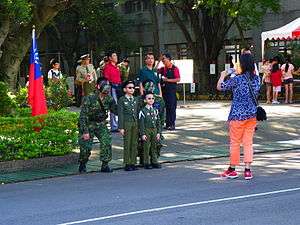

The ROC Armed Forces number approximately 300,000, and reserves reportedly total 3,870,000. Conscription remains universal for qualified males reaching age 18. Force streamlining programs under way since 1997 are combining redundant institutions and steadily reducing the military to 270,000 personnel by 2012. However, even then there would be compulsory basic training for all males reaching 18. As the size of the force decreases, the ROC intends to gradually expand the number of volunteer soldiers with the eventual goal of forming an all volunteer career force.[16]
The ROC Armed Forces' officer corps is generally viewed as being competent, displaying a high degree of professionalism. However, as a whole, the culture in the officer corps tends to be very cautious and conservative. The military also faces difficulties in the recruitment and retention of junior officers and NCOs due to competition with the private sector. There are, however, plans to make it a volunteer armed forces.
Because of the historical legacy having once controlled mainland China, the army has traditionally been the most important of the ROC's military forces, although this has declined in recent years with the realization that the traditional army's role in defending against a PRC invasion is limited. As a result, recent force modernization programs have resulted in the reorganization of the Army into smaller units as a quick deployment mobile troops. For the same reason, more emphasis is being placed on the development of the Navy and Air Force, in order to fend off attacks in the Taiwan Strait, away from Taiwan proper.[17]
Organization
_Chief_of_the_ROCA_General_Yen_Teh-fa_Opening_Speech_in_ROCMA_Open_Day_20140531.jpg)
Military branches and structure
The following service commands are directly subordinate to the General Staff, headed by the Chief of the General Staff, which answers to the civilian command structure under the Minister of Defense and the ROC President:[9]
- Republic of China Army (ROCA)
- Republic of China Navy (ROCN)
- Republic of China Marine Corps (ROCMC)
- Republic of China Air Force (ROCAF)
- Republic of China Military Police (ROCMP)
The Coast Guard Administration was created in 2001 from related police and military units and is administered by the Executive Yuan and may be incorporated as a military branch during times of emergency but for the large part remains in civilian control.
The position of Deputy Commander-in-Chief of the Combined Service Forces exists in the Republic of China military. The last known person to hold this position was Muslim Lt. Gen. Ma Ching-chiang.[18]
Arms purchases and weapons development
Acquisitions over the next several years will emphasize modern C 4 ISR equipment that will vastly improve communications and data-sharing among services. These and other planned acquisitions will gradually shift the island's strategic emphasis to offshore engagement of invading PRC forces. It is hoped that this will serve to reduce civilian casualties and damage to infrastructure in the event of armed conflict.[9]
The ROC's armed forces are equipped with weapons obtained primarily from the United States, examples being 150 F-16A/B Block-20 MLU fighters, 6 E-2 Hawkeyes, licensed produced Oliver Hazard Perry-class frigates, 63 AH-1W attack helicopters, 39 OH-58D scout helicopters and 3 batteries of Patriot PAC-II SAMs.
The ROC also procured two Hai Lung class submarines from the Netherlands, and 60 Mirage 2000-5Di/Ei fighter aircraft and six La Fayette stealth frigates from France. The ROC also has four German made minesweepers that were bought under the guise of civilian use.
In 2001 the United States approved the sale of a number of weapons systems, including eight diesel submarines, six Patriot PAC-3 SAMs and 12 P-3C Orion maritime patrol aircraft. Out of the items authorized, The ROC as of 2014 had four Kidd-class destroyers, M109A5 units, two additional E-2C Hawkeyes 2000 and nine CH-47SD Chinook heavy transport helicopters in service, with the 12 P-3C and 3 PAC-3 batteries being funded. It was unclear if or when the balance of the equipment would be supplied; the delivery of diesel submarines in particular was doubtful, as the United States does not manufacture them.
The military budget for 2007 (passed 16 June) included funds for the procurement of 12 P-3C Orion patrol aircraft, 66 F-16 C/D Block 52 fighters, the upgrade of existing PAC-2 batteries to PAC-3 standard and a feasibility study into the planned purchase of conventionally powered submarines offered by the US way back in 2001.
In July 2007 it was reported that the ROC Army would request the purchase of 30 AH-64D II Apache attack helicopters from in the 2008 defense budget.[19] The United Daily News reported that as many as 90 UH-60 Black Hawk helicopters would also be ordered to replace the UH-1Hs then in service.
During August, the ROC requested 60 AGM-84L Harpoon Block II missiles, 2 Harpoon guidance control units, 30 Harpoon containers, 30 Harpoon extended air-launch lugs, 50 Harpoon upgrade kits from AGM-84G to AGM-84L configuration and other related elements of logistics and program support, to a total value of US$125 million. The United States government indicated its approval of the order with notification to the United States Congress of the potential sale.[20]
In mid-September 2007, the Pentagon notified the U.S. Congress of P-3C Orion order, which included 12 Orions and three "spare aircraft", along with an order for 144 SM-2 Block IIIA missiles. The total value of the 12 P-3C Orions were estimated at around $1.96 billion and $272 million for the 144 SM-2 missiles.[21] A contract was awarded to Lockheed Martin to refurbish the 12 P-3C Orion aircraft for the ROC on 2009-03-13, with deliveries to start in 2012.[22]
In mid-November 2007, the Pentagon notified the US Congress about a possible sale to upgrade the ROC's existing 3 Patriot missile batteries to the PAC-3 standard. The total value of the upgrade could be as much as $939 million.[23]
The US government announced on 3 October that it planned to sell $6.5 billion worth of arms to the ROC ending the freeze of arms sales to the ROC. The plans include $2.5 billion worth of 30 AH-64D Block III Apache Longbow attack helicopters with night-vision sensors, radar, 174 Stinger Block I air-to-air missiles, 1,000 AGM-114L Hellfire missiles, PAC-3 missiles (330), 4 missile battery, radar sets, ground stations and other equipment valued up to $3.1 billion. 4 E-2T aircraft upgrade to E-2C Hawkeye 2000 was also included, worth up to $250 million. $200 million worth of submarine-launched Harpoon Block II missiles (32) would also be available for sale, $334 million worth of various aircraft spare parts and 182 Javelin missiles, with 20 Javelin command launchers.
However, not included in the arms sale were new F-16 C/D fighters, the feasibility study for diesel-electric submarines or UH-60 Black Hawk helicopters.[24] The White House had declined to sell 66 F-16C/D fighter planes as US Pacific Command has felt no need for advanced arms to be sold to the ROC.[25]
The military has also stressed military "self-reliance," which has led to the growth of indigenous military production, producing items such as the ROC's Indigenous Defense Fighter, the Thunderbolt 2000 Multiple Launch Rocket System, Clouded Leopard Armoured Vehicle, the Sky Bow I and Sky Bow II SAMs and Hsiung Feng series of anti-ship missiles.[9] The ROC's efforts at arms purchases have consistently been opposed by the PRC.[26] The PRC has also consistently attempted to block cooperation between the ROC military and those of other countries.
On 29 January 2010 the US government announced five notifications to US Congress for arms sales to the ROC, two Osprey class mine hunters for $105 million (all figures in US dollars), 25 Link 16 terminals on ships for $340 million, twn ship- and two air-launched Harpoon L/II for $37 million, 60 UH-60M and other related items for $3.1 billion and three PAC-3 batteries with 26 launchers and 114 PAC-3 missiles for $2.81 billion, for a total $6.392 billion overall.[27][28][29][30][31]
Reforms and development
Civilian control of the military
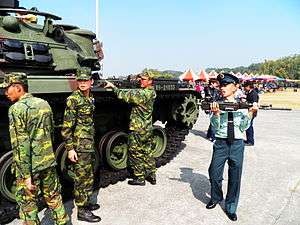
The modern day ROC military is styled after western military systems, mostly the US military. Internally, it has a political warfare branch/department that tightly controls and monitors each level of the ROC military, and reports directly to the General Headquarters of the ROC military, and if necessary, directly to the President of the ROC. This is a carryover from the pre-1949 era, when KMT and its army were penetrated by Communist agents repeatedly and led to frontline units defecting to Communist China. To strengthen their control over the military and prevent massive defection after retreating to Taiwan in 1949, CKS and CCK employed tight control over the military, by installing political officers and commissioners down to the company level, in order to ensure political correctness in the military and loyalty toward ROC leadership. This gave the political officers/commissars a great deal of power, allowing them to overrule the unit commander and take over the unit. Only in recent years has the political warfare department (due to cutbacks) reduced its power within the ROC military.
Two defense reform laws implemented in 2002 granted the civilian defense minister control over the entire military, and expanded legislative oversight authority for the first time in history.[32] In the past the ROC military was closely linked with and controlled by the KMT (Nationalist Party). Following the democratization of the 1990s the military moved to a politically neutral position, though the senior officer ranks remain dominated by KMT members.[33]
Doctrine and exercises
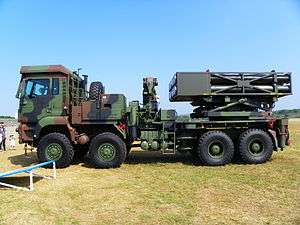
The primary goal of the ROC Armed Forces is to provide a credible deterrent against hostile action by establishing effective counterstrike and defense capabilities. Should hostilities occur, current ROC military doctrine centers upon the principle of "offshore engagement" where the primary goal of the armed forces in any conflict with the PRC would be to keep as much of the fighting away from Taiwan proper for as long as possible to minimize damage to infrastructure and civilian casualties. The military has also begun to take the threat of a sudden "decapitation attack" by the PRC seriously. Consequently, these developments have seen a growing emphasis on the role of the Navy and Air Force (where the Army had traditionally dominated); as well as the development of rapid reaction forces and quick mobilization of local reserve forces.[9]
Annually, the ROC Military conducts full exercises called Han Kuang Exercise which may sometimes include all branches of the military to participate in one or two specific exercises, they show the Taiwanese media the various weapons they have acquired and give special performances from the army, navy and air force. Han Kuang Exercises are held throughout Taiwan mainly at the main expected invasion areas. In 2007 there was an army exercise simulating a counterattack against PLA forces who have captured Taichung Port. An air force exercise simulating that air bases throughout Taiwan have been destroyed and are forced to use a major highway as an airstrip. ROCN (navy) exercise where an invasion force is heading toward Taiwan, destroyers, frigates and attack boats are called to fire missiles and attack dummy targets.
A series of computer simulations conducted by the ROC Ministry of National Defense in 2004 predicted that, in the event of a full-scale invasion by the PRC, Taipei would take at most three weeks to fall. It also showed that the ROC Air Force would be eliminated by about the fifth day. However, the simulation results indicate that the PRC would lose about two-thirds of all its military forces in the process. The results of the simulation are hotly debated since they came at a time when the Legislative Yuan was debating one of the largest arms procurement packages in recent years.[34]
Strategy
Taiwan figures itself in terms of China's long-term strategic planning. The island is part of China's First Island Chain, which encompass the innermost ring of islands China considers essential for national defense. Taiwan could then be used to protect mainland China and be used as a basing area to operate into the Second Island Chain. China no longer actively seeks to invade Taiwan, but has a large force oriented toward it if the decision was ever to be made, or to be used for options short of war to intimidate or demonstrate strength, such as a blockade. The Taiwanese military is made up of 290,000 personnel: 130,000 in the Army; 45,000 in the Navy and Marine Corps; and 80,000 in the Air Force. Though the Army had previously been the dominant service, the shift to a defensive orientation has shifted importance to the Navy and Air Force to conduct most fighting away from population centers. Given the current budgetary and numerical superiority of the Chinese military, Taiwan has moved towards an asymmetric anti-access/area denial system to imperil China's ability to operate in the Taiwan Strait rather than try to match its strength. The RoCN, which was once the most neglected force, has become the most important to defeat an invasion fleet. Combating the enemy fleet and sinking transport ships would take out large amounts of the ground invasion force and permanently degrade amphibious capabilities. Surface ships primarily consist of guided missile destroyers and frigates, as well as four dozen small, fast missile boats to take out much larger Chinese surface and amphibious ships. The RoCAF is optimized for air superiority and was once the more formidable of the two countries, but current Chinese technology investments have made China much more able to contest airspace. Air bases are likely to come under attack from some 1,500 Chinese conventional ballistic missiles in range of the island, with about 50 direct hits needed to put each one out of action. Taiwan has equipment to keep exposed bases operating while under fire with runway repair systems and mobile aircraft arresting systems. There are two hardened air bases used by the RoCAF: Chiashan Air Base is in a hollowed-out mountain that can protect 100 fighters, and a second facility is buried in the outskirts of Taipei. The RoCAF operates a nationwide air defense network to engage targets anywhere over the mainland; some anti-aircraft missile batteries are also located in underground silos. The Army would only fight if Chinese forces manage to land and would engage in asymmetric warfare. With all these measures, Taiwan Minister of National Defense Yen Ming believes that the country would be able to hold off a Chinese invasion for at least one month.[35]
Foreign cooperation
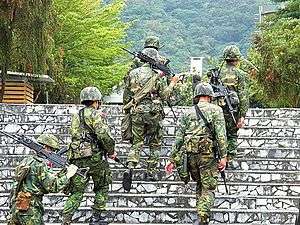
Japan
While some reports have also indicated the presence of retired Japan Self-Defense Forces (JSDF) personnel as advisers, there is no official cooperation between the ROC military and the JSDF. It is believed that any Japanese involvement in a cross-Straits conflict would be very much contingent upon the US response, due to the nearest US forces in the region being based in Japan and the Treaty of Mutual Cooperation and Security between the United States and Japan.[33]
Singapore
Starting in 1975, Singapore has sent units from its military to train in the Republic of China due to the lack of space in the city-state under the Starlight training program (星光計畫). Singaporean forces training in Taiwan numbered roughly 3000 as of 2005.[36] As of 2008, Singapore is the only foreign country to maintain permanent military bases on Taiwan.
Singapore being an island surrounded by larger countries found similarity with Taiwan; this might have contributed to its suitability as a training ground. However this became a point of conflict between Singapore and Beijing. Beijing demanded the withdrawal of troops and offered to provide alternative training ground on Hainan Island. Singapore refused the offer, rather stated it would withdraw its forces and not take part in any confrontation.
United States
Collaboration between the ROC and US militaries began during World War II when both nations were members of the Allied forces, and continued through the Chinese Civil War when ROC forces were supplied primarily by the US until the final evacuation of ROC forces to Taiwan in 1949. Initially the U.S. expected the ROC government to fall and withdrew support until the outbreak of the Korean War when the U.S. 7th Fleet was ordered to the Taiwan Straits both to protect Taiwan from a PRC attack, and to stop ROC actions against the PRC.[37] A formal US-ROC security pact was signed in 1954 establishing a formal alliance that lasted until US recognition of the PRC in 1979.[38] During this period US military advisers were deployed to the ROC and joint exercises were common. The United States Taiwan Defense Command was established in the Philippines for reinforcement of Taiwan airspace. The US and ROC also collaborated on human and electronic intelligence operations directed against the PRC. ROC units also participated in the Korean War and the Vietnam War in non-combat capacities, primarily at the insistence of the United States which was concerned that the high-profile roles for ROC forces in these conflicts would lead to full scale PRC intervention.[39]
High-level cooperation ended with the US recognition of the PRC in 1979, when all remaining US forces in Taiwan were withdrawn. The US continued to supply the ROC with arms sales per the Taiwan Relations Act, albeit in a diminished role. While ROCAF pilots continued to train at Luke AFB in Arizona, cooperation is still limited primarily to civilian contractors.
In recent years, the ROC military has again begun higher level cooperation with the U.S. Military after over two decades of relative isolation. Senior officers from the U.S. Pacific Command observed the annual Han Kuang military exercises in 2005. The US also upgraded its military liaison position in Taipei from a position held by retired officers hired on a contractual basis to one held by an active duty officer the same year.[40] The US remains committed to protecting Taiwan from PRC attack, though not if Taiwan were to declare formal independence first – Washington has stated it will not back such a declaration with military support.
Military parades

The Republic of China held their first military parade on 10 October 2007 for National Day celebrations since 1991. Previous parades were halted in an effort to ease the tension with the PRC. The parade was aimed at easing worries that the armed forces might be unprepared for a conflict with the PRC. The parade consisted of indigenous missiles, U.S. Patriot II and Avenger anti-missiles systems, U.S.-made F-16s, French-made Mirages and Taiwan-made IDF fighters.[41][42]
In 2015, another parade was held to mark the 70th anniversary of the defeat of Japan in 1945 in northern Hsinchu county. The parade was long at two hours and consisted of indigenous missiles, Apache helicopters and awards for World War II veterans. [43][44][45]
Military ranks
The ROC military's rank structure was initially patterned after the Wehrmacht of the 1930s. The titles of each rank are the same in Chinese for all four military branches. The corresponding titles in English for each service are listed.[46]
| Chinese title | Army / Marines / MP | Navy | Air Force |
|---|---|---|---|
| 一級上將 | Superior General 1st Grade | Superior Admiral 1st Grade | Superior General 1st Grade |
| 二級上將 | Superior General 2nd Grade | Superior Admiral 2nd Grade | Superior General 2nd Grade |
| 中將 | Standard General | Vice Admiral | Lieutenant General |
| 少將 | Inferior General | Rear Admiral | Major General |
| 上校 | Senior Field Officer | Captain | Colonel |
| 中校 | Standard Field Officer | Commander | Lieutenant Colonel |
| 少校 | Inferior Field Officer | Lieutenant Commander | Major |
| 上尉 | Senior Subaltern | Lieutenant | Captain |
| 中尉 | Standard Subaltern | Lieutenant Junior Grade | 1st Lieutenant |
| 少尉 | Junior Subaltern | Ensign | 2nd Lieutenant |
| Chinese title | Army / Marines / MP | Navy | Air Force |
|---|---|---|---|
| 一等士官長 | Sergeant Commander 1st Class | Master Chief Petty Officer | Chief Master Sergeant |
| 二等士官長 | Sergeant Commander 2nd Class | Senior Chief Petty Officer | Senior Master Sergeant |
| 三等士官長 | Sergeant Commander 3rd Class | Chief Petty Officer | Master Sergeant |
| 上士 | Superior Sergeant | Petty Officer 1st Class | Technical Sergeant |
| 中士 | Standard Sergeant | Petty Officer 2nd Class | Staff Sergeant |
| 下士 | Inferior Sergeant | Petty Officer 3rd Class | Senior Airman |
| 上等兵 | Superior Private | Leading Seaman | Airman First Class |
| 一等兵 | Private 1st Class | Seaman | Airman |
| 二等兵 | Private 2nd Class | Seaman Apprentice | Airman Basic |
Major deployments, battles and incidents
1912–1949
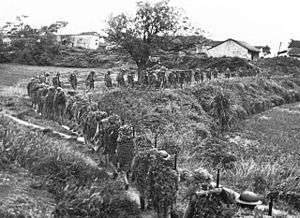
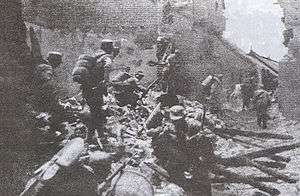
- Northern Expedition: 1926–1928
- Central Plains War: May 1930 – November 4, 1930
- First Communist Insurrection/Purge: 1927–1937
- Nanchang Uprising: 1927
- Autumn Harvest Uprising: 1927
- Xi'an Incident: December 12, 1936
- Second Sino-Japanese War/World War II: 1937–1945
- Marco Polo Bridge Incident: July 7, 1937
- Battle of Shanghai: August 13 – November 9, 1937
- Battle of Nanjing: October–December, 1937
- Battle of Taierzhuang: March 24 – April 7, 1938
- First Battle of Changsha: September 17 – October 6, 1939
- Second Battle of Changsha: September 6 – October 8, 1941
- Third Battle of Changsha: December 24, 1941 – January 15, 1942
- Defense of Sichuan: 1942–1943
- Battle of Hengyang-Changsha: June 1944 – April 1945
- Chinese Civil War: 1946–1950
- New Fourth Army Incident: 1940
- February 28 Incident: February 28 – March 1947
Since 1949
- Battle of Kuningtou: October 25–28, 1949
- Battle of Dengbu Island: November 3 – 5, 1949
- Hainan Campaign: March 5, 1950 – May 1, 1950
- First Battle of Dadan island: July 26, 1950
- Korean War: 1950–1953, Translators, cross border raids into southwest China from Burma.[47]
- Battle of Nanri island: April 11 – 15, 1952
- Dongshan Island Campaign: July 15, 1953
- First Taiwan Strait Crisis: August 1954 – May 1955
- Battle of Yijiangshan: January 18, 1955
- Tachen Evacuation: February 7–11, 1955
- Second Taiwan Strait Crisis (August 23 Artillery Battle): August 23 – early October 1958
- Second Battle of Dadan island: August 26, 1958
- Vietnam War: 1960s, Deployment of small groups of ROC troops disguised as locals, transportation, and technical assistance. Not widely publicized to avoid PRC involvement.[39]
- Battle of Dong-Yin: May 1, 1965
- Battle of Wuchow: November 13–14, 1965
- Yemen Civil War: 1979 to 1985: 80+ F-5E pilots plus ground crew sent to North Yemen to boost its air defense, under US support/direction. At least one squadron strength was kept throughout the period, flying North Yemen's F-5E fleet.[48]
- Third Taiwan Strait Crisis: July 21, 1995 – March 23, 1996
- Southeast Asian tsunami relief: January 2005
- Military intervention against ISIL: June 13, 2014 – present (Under CJTF-OIR)
Nuclear weapons program
The development of nuclear weapons by the ROC has been a contentious issue. The U.S., hoping to avoid escalating tensions in the Taiwan Strait, has continually opposed arming the ROC with nuclear weapons. Accordingly, the ROC, although not a member of the United Nations, adheres to the principles of the nuclear Non-Proliferation Treaty and has stated that it does not intend to produce nuclear weapons. Past nuclear research by the ROC makes it a 'threshold' nuclear state.
In 1967, a nuclear weapons program began under the auspices of the Institute of Nuclear Energy Research (INER) at the Chungshan Institute of Science and Technology. The ROC was able to acquire nuclear technology from abroad (including a research reactor from Canada and low-grade plutonium from the United States) allegedly for a civilian energy system, but in actuality to develop fuel for nuclear weapons.[49]
After the International Atomic Energy Agency found evidence of the ROC's efforts to produce weapons-grade plutonium, Taipei agreed in September 1976 under U.S. pressure to dismantle its nuclear weapons program. The nuclear reactor was soon shut down and the plutonium mostly returned to the U.S.
A secret program was revealed when Colonel Chang Hsien-yi, deputy director of nuclear research at INER who was secretly working for the CIA, defected to the U.S. in December 1987 and produced a cache of incriminating documents. General Hau Pei-tsun claimed that scientists in Taiwan had already produced a controlled nuclear reaction.[50] Under pressure from the U.S., the program was halted.
During the 1995–1996 Taiwan Strait crisis, ROC President Lee Teng-hui proposed to reactivate the program, but was forced to back down a few days later after drawing intense criticism from the U.S. government.[51]
With the unbalanced military equation across the Taiwan Strait, Taipei may choose nuclear weapons as a deterrent against the military encirclement by the People's Republic of China.[50][52][53]
Budget
| Taiwan Defense Budget | ||
|---|---|---|
| Year | Nominal | Percentage of GDP |
| 1996 | US$9.57 billion | 3.6% |
| 1998 | US$9.46 billion | 3.26% |
| 1999 | US$8.89 billion | 3.06% |
| 2008 | US$10.9 billion | 2.94% |
Chief of the General Staffs
_Promotion_of_Lee_Hsi-ming_to_Admiral_%E6%9D%8E%E5%96%9C%E6%98%8E%E6%99%89%E4%BB%BB%E6%B5%B7%E8%BB%8D%E4%B8%8A%E5%B0%87_(20150130_%E7%B8%BD%E7%B5%B1%E4%B8%BB%E6%8C%81%E5%9C%8B%E8%BB%8D%E9%87%8D%E8%A6%81%E5%B9%B9%E9%83%A8%E6%99%89%E4%BB%BB%E5%B8%83%E9%81%94%E6%8E%88%E9%9A%8E%E5%85%B8%E7%A6%AE).png)
- Lin Chen-yi (5 February 2009 – 15 January 2013)
- Yen Ming (16 January 2013 – 7 August 2013)
- Kao Kuang-chi (8 August 2013 – 30 January 2015)
- Yen Teh-fa (30 January 2015 – 30 November 2016)
- Chiu Kuo-cheng (1 December 2016 – 28 April 2017)
- Lee Hsi-ming (28 April 2017 –)
See also
References
- ↑ https://www.sipri.org/sites/default/files/1_Data%20for%20all%20countries%20from%201988%E2%80%932017%20in%20constant%20%282016%29%20USD.pdf
- ↑ Look at Dutch-built Zwaardvis class submarine
- ↑ "中華民國憲法 制憲之國民大會制定於民國35年12月25日(現行條文) 第一百三十八條 (軍隊國家化|軍人超然) 全國陸海空軍,須超出個人、地域及黨派關係以外,效忠國家,愛護人民; Zhōnghuá Mínguó xiànfǎ zhì xiàn. Zhī guómín dàhuì zhìdìng yú mínguó 35 nián 12 yuè 25 rì (Xiànxíng tiáowén). Dìyī bǎi sānshí bā tiáo (Jūnduì guójiā huā - jūnrén chāorán) Quánguó lùhǎikōngjūn, xū chāochū gèrén, dìyù jí dǎngpài guānxi yǐwài, xiàozhōng guójiā, àihù rénmín.; English translation http://english.president.gov.tw/Default.aspx?tabid=1118 (Constitution of the Republic of China Clause 138 – National Defence – The land, sea and air forces of the whole country shall be above personal, regional, or party affiliations, shall be loyal to the state, and shall protect the people.)". Wikisource. Retrieved 2014-01-14. External link in
|title=(help) - ↑ http://www.timetw.com/48873.html
- ↑ Team, Discuz! Team & Comsenz UI. "軍中有青幫的存在嗎?(頁 2) - 肝膽相照區 - 後備弟兄Q&A - 中華民國後備憲兵論壇 - ROCMP Forum - 和平 勇敢 廉潔 慧敏 - ROCMP.org - Powered by Discuz! Archiver". www.rocmp.org.
- ↑ "杜月笙台軍里的門生余脈:今日台軍中的青幫".
- ↑ "Overview – Taiwan Military Agencies". globalsecurity.org. Retrieved 2006-03-05.
- ↑ "2004 National Defense White Paper" (PDF). ROC Ministry of National Defense. Archived from the original (PDF) on September 1, 2006. Retrieved 2006-03-05.
- 1 2 3 4 5 "2004 National Defense Report" (PDF). ROC Ministry of National Defense. 2004. Archived from the original (PDF) on March 11, 2006. Retrieved 2006-03-05.
- ↑ 第三十二条 国军之组织,以义务民兵制为基础 (Clause 32, Organization of Nationalist Army, with volunteer militia as its foundation)
- ↑ Isenberg, David. "Shifting Defense Expenditures in East Asia." Time, 26 October 2012.
- ↑ Pike, John. "Upgrade of F16 fleet squeezes budgets for other weapons: minister". globalsecurity.org. Retrieved 30 January 2016.
- ↑ Cole, Michael J. "Taipei cuts budget for F-16 upgrades." Taipei Times, 10 February 2012.
- ↑ "Taiwan hopes upgraded fighters will be on par with F-16C/Ds." ROC Central News Agency, 14 May 2012.
- ↑ "Taiwan's Declining Defense Spending Could Jeopardize Military Preparedness". uscc.gov. Archived from the original on 1 January 2016. Retrieved 30 January 2016.
- ↑ "Ministry of National Defense – Taiwan Military Agencies". globalsecurity.org. Retrieved 2006-03-05.
- ↑ Roy, Denny (2003). "Taiwan's Threat Perceptions: The Enemy Within" (PDF). Asia-Pacific Center for Security Studies.
- ↑ Gowing, Peter G. (July–August 1970). "Islam in Taiwan". SAUDI ARAMCO World. Archived from the original on 2014-09-11. Retrieved 2014-05-07.
- ↑ "Apache helicopter most suited to the ROC's defense needs: Army". Central News Agency. 2007-08-10. Archived from the original on September 27, 2007. Retrieved 2007-08-10.
- ↑ "Congress notified of possible anti-ship missile sale to Taiwan". Yahoo! news. 2007-08-09. Retrieved 2007-09-13.
- ↑ "Pentagon could make 2.2 billion dollar arms sales to Taiwan". Yahoo! news. 2007-09-13. Retrieved 2007-09-13.
- ↑ "U.S. in deal to refurbish aircraft for Taiwan". Washington Post. 2009-03-13. Retrieved 2007-09-13.
- ↑ "Taipei Economic and Cultural Representative Office in the United States – PATRIOT Configuration 2 Ground Systems Upgrade" (PDF). Defense News. 2007-11-09. Archived from the original (PDF) on 2007-11-28. Retrieved 2007-11-14.
- ↑ "Taiwan supporters laud weapons sale". Taipei Times. 2008. Retrieved 2008-10-05.
- ↑ "U.S. declines to sell F-16 fighter jets to Taiwan:MP". Reuters. 2009-03-10. Retrieved 2009-03-12.
- ↑ "China expresses strong indignation for "US-Taiwan defense conference": FM spokesman". People's Daily. 2004-10-10. Retrieved 2006-03-05.
- ↑ "USDA New Release" (PDF). dsca.mil. 2010-01-29. Archived from the original (PDF) on 2011-07-21. Retrieved 2010-01-29.
- ↑ "USDA New Release" (PDF). dsca.mil. 2010-01-29. Archived from the original (PDF) on 2011-07-21. Retrieved 2010-01-29.
- ↑ "USDA New Release" (PDF). dsca.mil. 2010-01-29. Archived from the original (PDF) on 2011-07-21. Retrieved 2010-01-29.
- ↑ "USDA New Release" (PDF). dsca.mil. 2010-01-29. Archived from the original (PDF) on 2011-07-21. Retrieved 2010-01-29.
- ↑ "USDA New Release" (PDF). dsca.mil. 2010-01-29. Archived from the original (PDF) on 2011-07-21. Retrieved 2010-01-29.
- ↑ Peter, Brookes (2003). "U.S.-Taiwan Defense Relations in the Bush Administration". Heritage Lecture #808. The Heritage Foundation. Archived from the original on 2006-03-16. Retrieved 2006-03-05.
- 1 2 Swaine, Michael D.; Mulvenon, James C. (2001). "3". Tawian's Foreign and Defense Policies: Features and Determinants (PDF). RAND Corporation. p. 65. ISBN 0-8330-3094-9. Retrieved 2006-03-05.
- ↑ Shlapak, David; David T. Orletsky; Barry Wilson (2000). "2" (PDF). Dire Strait? Military Aspects of the China-Taiwan Confrontation and Options for U.S. Policy (PDF). RAND Corporation. pp. 7–30. ISBN 0-8330-2897-9. Retrieved 2006-03-05. Example of a simulated wargame of a cross-straits conflict.
- ↑ How Taiwan Would Defend Against a Chinese Attack – News.USNI.org, 26 March 2014
- ↑ "「星光」重要性不如以往" ["Starlight" not as important as it once was]. The Liberty Times. 2005-03-10. (in Taiwanese Mandarin)
- ↑ U.S. Department of Defense (1950). "Classified Teletype Conference, dated June 27, 1950, between the Pentagon and General Douglas MacArthur regarding authorization to use naval and air forces in support of South Korea. Papers of Harry S. Truman: Naval Aide Files". Truman Presidential Library & Museum.
- ↑ "Mutual Defense Treaty between the United States of America and the Republic of China". taiwandocuments.org. Retrieved 2006-03-05.
- 1 2 S. Goldstein (2000). "The United States and the Republic of China, 1949–1978: Suspicious Allies" (PDF). Freeman Spogli Institute for International Studies, Stanford University. Archived from the original (PDF) on 2006-02-17.
- ↑ "Military attache starts work at AIT next month". The Taipei Times. 2005-07-30.
- ↑ HUANG, ANNIE (2007-10-10). "Taiwan Stages Military Parade". The Washington Post. ISSN 0190-8286. Retrieved 2017-03-16.
- ↑ Lague, David (2007-10-11). "China Announces Gains in Air Defense". The New York Times. ISSN 0362-4331. Retrieved 2017-03-16.
- ↑ Post, The Jakarta. "Taiwan to hold military parade marking WWII anniversary". The Jakarta Post. Retrieved 2017-03-16.
- ↑ "Taiwan stands up to China with World War II military parade". USA TODAY. Retrieved 2017-03-16.
- ↑ (www.dw.com), Deutsche Welle. "Taiwan marks WWII victory over Japan with military parade | News | DW.COM | 04.07.2015". DW.COM. Retrieved 2017-03-16.
- ↑ "Taiwan". The International Encyclopedia of Uniform Insignia Around the World. Archived from the original on September 26, 2007. Retrieved 2006-03-05.
- ↑ Kaufman, Victor S. "Trouble in the Golden Triangle: The United States, Taiwan and the 93rd Nationalist Division". The China Quarterly. No. 166, Jun., 2001. p.441. Retrieved March 6, 2011.
- ↑ Foreign Policy in Focus, Yemen, the United States, and Al-Qaida. December 19, 2001, retrieved Sept. 19, 2009 Archived July 26, 2009, at the Wayback Machine.
- ↑ Roy, Denny (2003). Taiwan: A Political History. Cornell University Press. ISBN 0-8014-8805-2.
- 1 2 "美高官:美国坚决反对台湾走上核武器"险路"-搜狐新闻中心". sohu.com. Retrieved 30 January 2016.
- ↑ Mitchell, Derek J. (2005). "Part 2: Case Studies: Taiwan". The nuclear tipping point: Why states reconsider their nuclear choices. Brookings Institution Press. p. 308.
- ↑ "美高官:美国坚决反对台湾走上核武器"险路"-搜狐新闻中心". sohu.com. Retrieved 30 January 2016.
- ↑ "美高官:美国坚决反对台湾走上核武器"险路"-搜狐新闻中心". sohu.com. Retrieved 30 January 2016.
- ↑ Pike, John. "Defense Budget - Taiwan". www.globalsecurity.org.
External links
| Wikimedia Commons has media related to Military of the Republic of China. |
- ROC Ministry of National Defense Official Website (in Chinese) (in English)
- The Armed Forces Museum of ROC (in English)
- National Revolutionary Martyrs' Shrine of R.O.C (in Chinese)(in English)(in Japanese)(in Korean)

